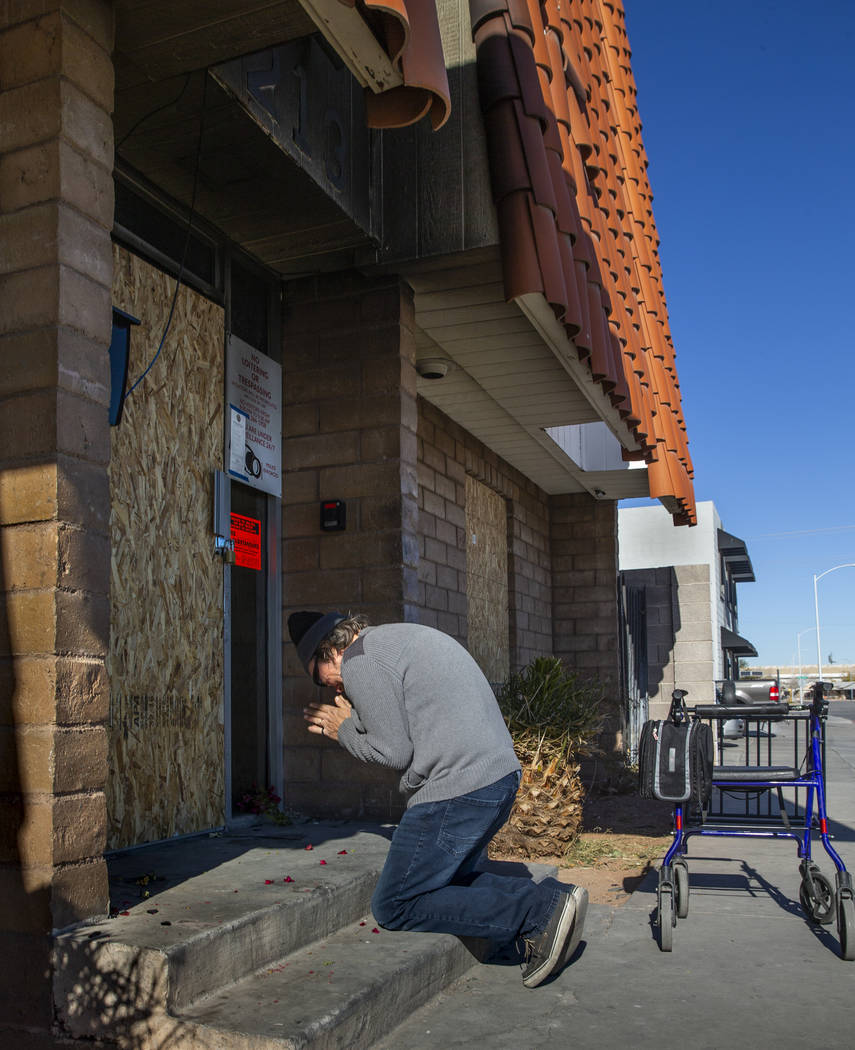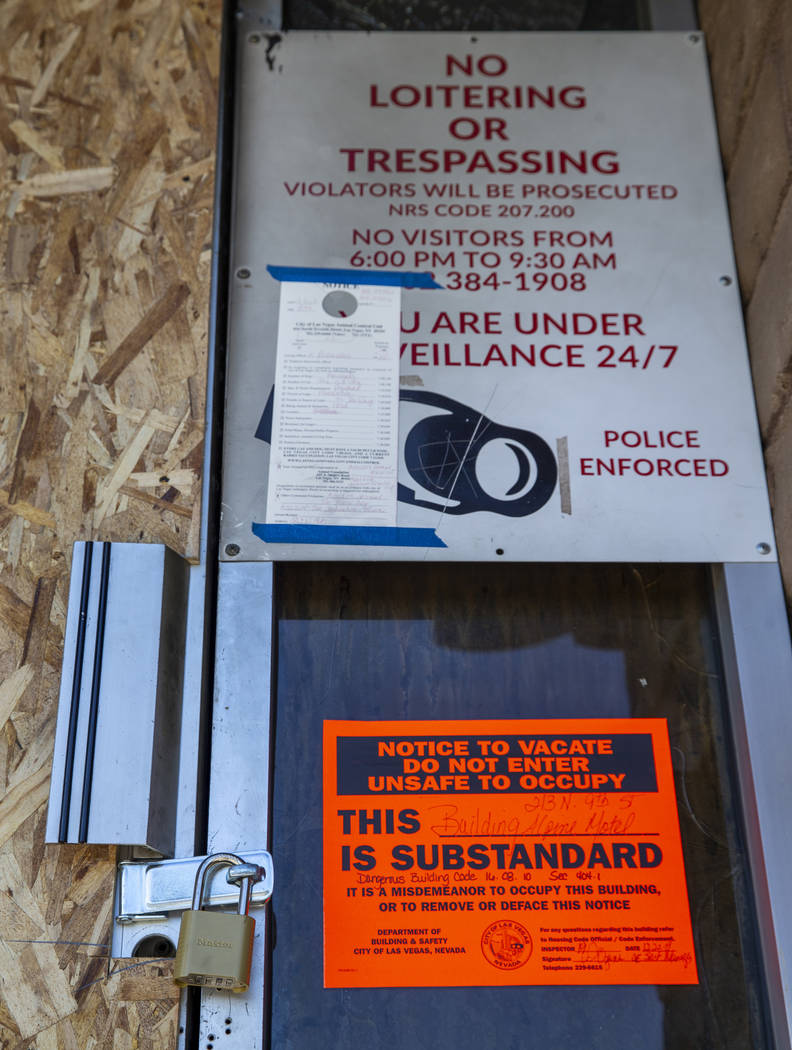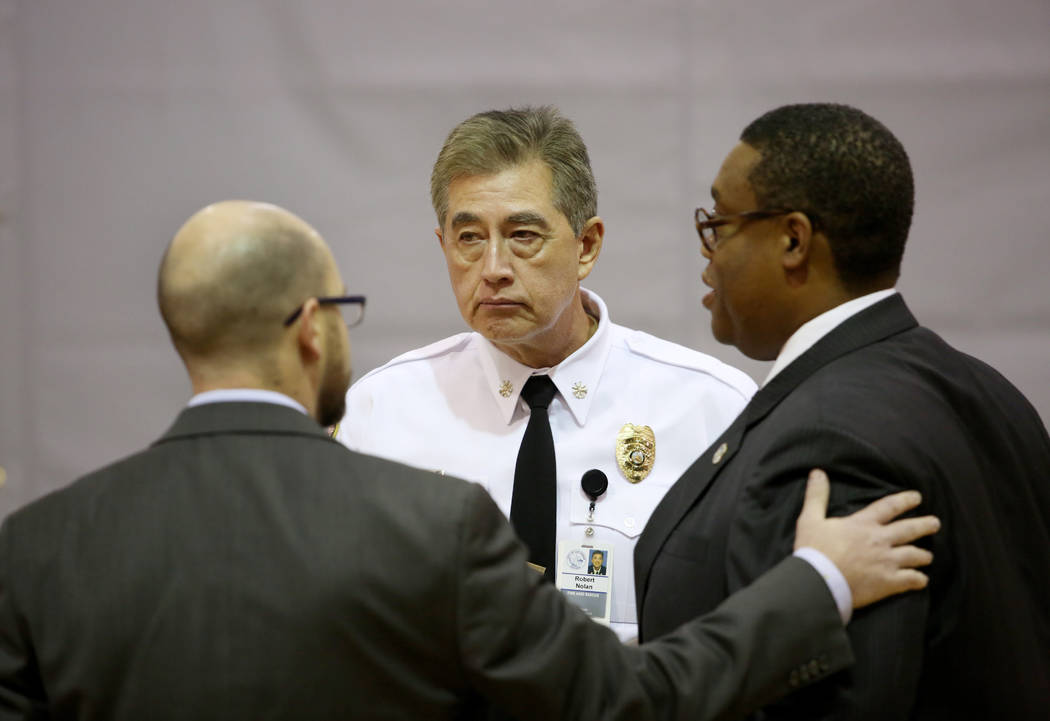Did a gap in fire inspections put Alpine apartments at risk?
The downtown Las Vegas apartment building where a December fire left six people dead and 13 injured went more than two years without a fire inspection, despite a history of failed inspections going back more than a decade.
When inspectors returned on Dec. 22 and 23, 2019 — two days after the city’s deadliest residential fire — 42 fire code violations were noted, including an exit door bolted from the outside, security bars in a sleeping area without an emergency release, and missing or defective smoke detectors in at least 14 locations throughout the building, records show.
Las Vegas Fire Marshal Robert Nolan said he regrets that his office failed to inspect the Alpine Motel Apartments in the 32 months leading up to the fire.
“That’s on me,” Nolan said. “In hindsight, I wish we would have gone back there.”
Fire department records obtained by the Review-Journal show Nolan’s inspectors hadn’t visited the three-story building for an annual inspection since April 26, 2017.
After the fire, inspectors returned to the scene with Las Vegas police as part of a post-fire analysis aimed at helping officers conduct a criminal investigation. Nolan said this was not a regular inspection. “We pointed out things that Metro was interested in that may have contributed to the fire.”
Inspectors found fire doors not closing properly, no emergency lighting and daisy-chaining extension cords. Vending machines also were obstructing an exit pathway. Another violation stated the fire alarm system was defective, with an alarm panel “strapped.” Nolan said that was a makeshift attempt to portray the panel as working properly for inspectors.
Robert Solomon, an engineer with the National Fire Protection Association, said the list of violations amounted to one of the worst cases he’s seen in his career.
“It’s like, wow — somebody obviously didn’t care about the building, which means they probably didn’t care about the people in the building,” Solomon said after reviewing the list. “I don’t in any way want to discount that six people died. But they’re fortunate it was only six.”
The early-morning fire was believed to have originated from a stove being used to heat a first-floor apartment. Records show inspectors found several examples of ovens turned on with open doors. Residents told the Las Vegas Review-Journal the building had no working heat.
Trapped by the bolted rear exit door and choked by overwhelming smoke, residents, including a pregnant woman, resorted to jumping from second- and third-story windows to escape.
Las Vegas Fire Department reports show a long list of failed inspections between 2013 and 2017 under the Alpine’s current owner, Las Vegas Dragon Hotel LLC.
In 2016, the property, built in 1972, failed three fire inspections in one month.
In 2017, it failed three more inspections.
During the last inspection before the fire, the Alpine’s case in April 2017 was deemed “closed” and referred to a proposed team meant to focus on safety at low-income apartment complexes, records show.
But Nolan said the Alpine did not end up qualifying for the program because the city did not license the building as an apartment complex. City records show it’s licensed as a residence hotel — even though the Southern Nevada Health District considers it a private residence.
In May 2017, Nolan said the Alpine fell back into the fire marshal’s general inspection cycle, handled by a single inspector who had other cases and priorities. No fire code complaints from residents were filed against the property during that time, he said.
The differing code designations attributed to the Alpine may have created confusion among Las Vegas agencies responsible for inspecting the building.
So the downtown property seemingly fell through the cracks.
Calls for expanded investigation
Las Vegas Mayor Carolyn Goodman said Tuesday she had not read the city’s fire inspection report on the Alpine, but she considered the findings “intolerable.” She called for an expanded investigation into Las Vegas Dragon Hotel LLC and the company’s managing member, Adolfo Orozco.
“I want to make sure all of his properties are thoroughly investigated,” she added.
City Councilman Cedric Crear said the city will be thorough in its investigation of the Alpine. “We are going to do our due diligence, we’re going to have an in-depth investigation, and we’re going to find out who and what’s accountable for this.”
Both Goodman and Crear, whose Ward 5 includes the Alpine, said they were concerned about the lengthy gap between inspections prior to the fire.
“We’re going to look at all of our staffing,” Crear said. “We’re going to look to the Legislature to see what assistance they can provide. We’re definitely going to take a hard look at the entire process.”
Longtime attorney Dominic Gentile, who represents Las Vegas Dragon Hotel LLC and Orozco, said he could not comment on the post-fire violations found by city inspectors.
“Until I see the report, I’m really not in a position to make a comment,” said Gentile, who is part of a 10-member defense team hired by the property’s ownership to conduct a fact-finding investigation into the fire.
A 2018 Las Vegas Review-Journal investigation found the valley’s fatal fires were clustered in older homes and apartments in the valley’s urban core, where current safety measures like sprinklers and interconnected smoke alarms are not required.
In terms of fire inspections and equipment testing, city of Las Vegas fire code appears to defer to National Fire Protection Association standards, which put the onus on the property owner to hire private contractors for annual fire inspection and equipment testing.
Public inspectors would then be responsible for verifying that those inspections and tests were completed.
But Solomon, with the National Fire Protection Association, said there is no set schedule for public inspectors to verify that private inspections and tests are happening as often as they should be.
“In an ideal world, we’d want to see these buildings annually,” Solomon said. “But bottom line, it’s a resource issue. That’s why the codes are very specific about who carries the responsibility.”
Solomon said the Alpine’s extensive post-fire violations may suggest the property owner did not regularly hire contractors to conduct private inspections or test equipment in the interim.
Gentile said that “if Mr. Solomon would take the time to do the inspection, he might have more credibility.”
“For him to make a comment like that without seeing it, is not very professional,” he said.
Scotti Hughes, who spent time with Tracy Cihal the night before she died in the Alpine blaze, criticized the lapse in Alpine inspections prior to the fire.
“Falling through the cracks is not an excuse,” Hughes said, adding that it sounded like inspectors got lazy or simply didn’t care to follow up since 2017.
“You know, just because it’s low-income, just because it’s not in the greatest of neighborhoods — it doesn’t mean there’s not real people who live there,” Hughes said. “If it was in Summerlin, it totally wouldn’t have fell through the cracks.”
Alpine inspection records
From Oct. 2, 2006, until the property was acquired by Las Vegas Dragon Hotel LLC in 2013, the Alpine had nine fire code inspections. It passed six of them and failed three, city records show.
Between January 2013 and the day of the fire, 14 inspections were conducted at the Alpine during the tenure of the new owner. The building failed 11 of them, passed one and partially passed another. The last was in April 2017, when the case was “closed.”
Nolan acknowledged that the property had problems keeping up to code over the years.
“When you look at their history, there were a lot of violations,” he said. “But there also was a lot of compliance. They fixed things.”
Nolan said in the aftermath of the fire, his office and other city departments are participating in a wide-ranging review spearheaded by the city manager’s office aimed at preventing another low-income housing tragedy.
“I was shocked at the high loss of life,” said Nolan, who recalled seeing the bodies of four victims at the fire scene. “It was needless. Most of the people died in a hallway from toxic smoke inhalation. They just didn’t know a second way out of their rooms.”
Rooms on the first floor had windows just a couple of feet high that people could have jumped out of, he said.
At midday Friday, the Alpine’s first-floor windows and both front and rear exit doors were boarded up with plywood. Black soot from smoke could be seen above multiple window casings and vent hoods mounted on the off-white walls. Several candles had been left on the building’s front steps in memory of those who died. A security guard was in the parking lot, explaining that Orozco’s attorney had hired security on Dec. 31 to monitor the property around the clock.
Goodman said the violations at the Alpine underscore the need for more frequent, proactive inspections at the city’s apartments.
She said tenants should reach out to the city if they believe their living environments are unsafe, but she also noted that vulnerable and low-income tenants may be afraid to speak out because they fear retaliation from their landlord.
“We cannot rely on the occupant to tell us when things are compromised,” she said. “There has to be constant enforcement, constant visitations to the properties and a look back at what are the policies we have in place.”
One former Alpine resident, Floyd Guenther, who worked to save several third-floor residents the night of the fire, said he had no idea the city had failed to inspect the property since April 2017.
Guenther wondered if the fire could have been prevented had the property been inspected regularly.
“My face is turning red right now,” he said. “I’m really pissed off. I don’t understand where these inspectors are coming from.”
Guenther had been living at the Alpine for three months. In that time, he said he submitted two handwritten work orders to the building’s front office, both of which requested that his smoke detectors be replaced, as they did not work even after he personally replaced the batteries. He said he never received a response for those work orders, and on the night of the fire, his smoke detectors did not work.
As he pounded on doors to wake and save residents, Guenther said he also yanked on fire alarm pull stations throughout the building, trying to activate the alarm system. But none of them worked.
Lawsuit filed
While city officials have said no code enforcement investigations were open at the time of the fire, the Alpine was the subject of at least eight building code complaints from 2016 through 2018, according to city records.
A tenant who called in May 2019 about an alleged bug infestation and sink leaks was told by the city to contact the health district instead.
But because the health district considered the property a private residence, the agency was not obligated to inspect the Alpine regularly or investigate complaints against the property, unless they were about essential services like nonworking heat or water, environmental health supervisor Viverk Raman said.
A separate tenant who reached out to the city in August about a “caved in” ceiling, bug infestation and mold problems was told the city didn’t investigate mold issues.
And in November, a tenant reported the outlets inside her unit were sparking. City code inspectors closed the case without investigating it because they could not reach her by phone.
Several weeks before the fire, Las Vegas businessman Donald Walford on Oct. 8 photographed black metal bars covering the exterior of the building’s exit door. The bars were removed within a few days, Walford previously told the Review-Journal.
But at some point before the fire, the exit door was again secured shut, records show. The documents also point to a history of concern from Las Vegas fire inspectors about exits at the building that predate the Alpine’s current owner.
“Far and away, the biggest concern is the back door being bolted from the exterior,” said Jim Begley, founder of the Las Vegas-based fire protection engineering firm TERPconsulting. “It’s fire safety 101. People need a way to get out of the building.
“I would suspect if you delved into it, you would find there’s a correlation between open inspection items and the rental values of these types of buildings,” he said. “You wouldn’t walk into a high-end Strip resort and find these types of violations.”
A day after the post-fire inspection records were released, the family of Alpine victim Cihal, 57, filed a wrongful death lawsuit against Alpine ownership, including Las Vegas Dragon Hotel LLC and Orozco. It marked the first civil case brought against the property’s ownership since the deadly fire.
Despite the nearly three-year gap in fire inspections at the property, Nolan defended his inspector’s handling of the Alpine case.
“His priorities did not allow him to get back to the property,” Nolan said, noting inspectors are also responsible for new construction inspections and arranging temporary use permits for special events, among other duties.
“I stand by my inspectors,” Nolan continued. “I’m very proud of the work they do.”
The Review-Journal’s investigative team focuses on reporting that holds leaders and agencies accountable and exposes wrongdoing. Contact Jeff German at jgerman@reviewjournal.com or 702-380-4564 and Glenn Puit at gpuit@reviewjournal.com or 702-383-0390. Contact Michael Scott Davidson at sdavidson@reviewjournal.com and Rachel Crosby at rcrosby@reviewjournal.com. Staff writer Rio Lacanlale contributed to this story.



































